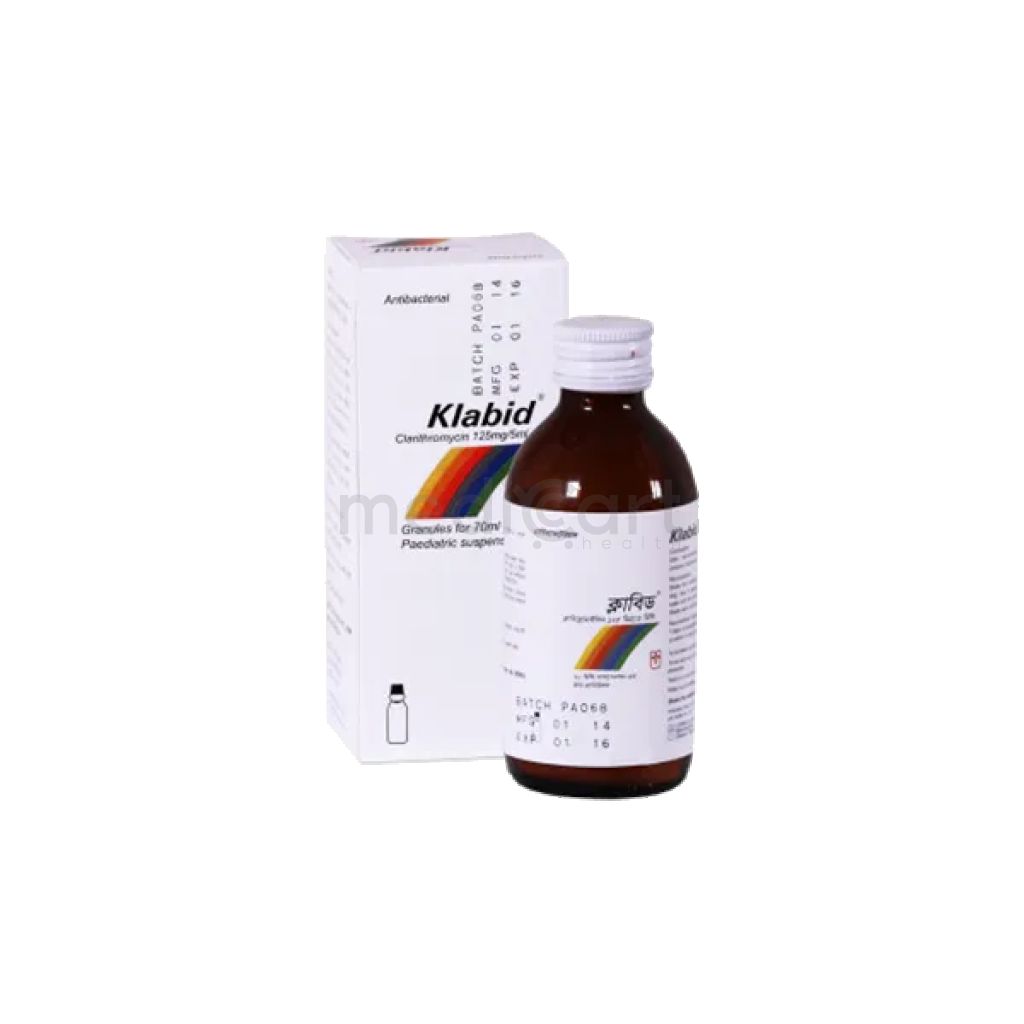

Klabid 70ml Paed Suspension 70 ml
Suppository
Pack Size :
1 bottle x 1 packet
Generics :
Clarithromycin
Manufacturer :
Unimed & Unihealth Manufacturers Ltd.
Best Price *
TK
390.00
* Delivery will be done in Dhaka city only.
Alternative Product
More Information About - Klabid 70ml Paed Suspension 70 ml
Description
Generic Name
ClarithromycinPrecaution
Renal and hepatic impairment; macrolide cross-resistance; lactation, children. Lactation: Drug is excreted in breast milk; use with cautionIndication
Respiratory tract infections, Skin and soft tissue infections, Leprosy, peptic ulcer disease, pharyngitis, tonsillitis, acute maxillary sinusitis, acute bacterial exacerbation of chronic bronchitis, pneumonia, legionellosis, Helicobacter pylori, lyme disease, Community-Acquired Pneumonia.Contra Indication
Hypersensitivity. Patients receiving terfenadine, astemizole, pimozide, cisapride and ergot derivatives. Pregnancy; history of acute porphyria.Dose
N/ASide Effect
>10% Gastrointestinal (GI) effects, general (13%) 1-10% Abnormal taste (adults, 3-7%),Diarrhea (3-6%),Nausea (adults, 3-6%),Vomiting (adults, 1%; children, 6%),Elevated blood urea nitrogen (BUN; 4%),Abdominal pain (adults, 2%; children, 3%),Rash (children, 3%),Dyspepsia (2%),Heartburn (adults, 2%),Headache (2%),Elevated prothrombin time (PT; 1%) <1% Anaphylaxis,Anorexia,Anxiety,Clostridium difficile colitis,Dizziness,Dyspnea,Elevated liver function tests,Glossitis,Hallucinations,Hepatic dysfunction,Hepatitis,Hypoglycemia,Increased alkaline phosphatase,Increased aspartate aminotransferase,Increased bilirubin,Increased serum creatinine,Jaundice,Leukopenia,Manic behavior,Neuromuscular blockade,Neutropenia,Pancreatitis,Psychosis,QT prolongation,Seizures,Stevens-Johnson syndrome,Thrombocytopenia Potentially Fatal: Pseudomembranous colitis, anaphylaxis, Stevens-Johnson syndrome.Pregnancy Category
Name : C
Description
Animal reproduction studies have shown an adverse effect on the fetus and there are no adequate and well-controlled studies in humans, but potential benefits may warrant use of the drug in pregnant women despite potential risksMode of Action
Clarithromycin inhibits protein synthesis by binding to 50s ribosomal subunits of susceptible organisms. It has activity against susceptible streptococci and staphylococci as well as other species including B. catarrhalis, L. spp, C. trachomatis and U. urealyticum.Interaction
Reduced efficacy w/ CYP3A inducers (e.g. phenytoin, carbamazepine). Strong inducers of CYP450 system (e.g. efavirenz, rifampicin) may accelerate metabolism, thus lower plasma levels of clarithromycin. Inhibition of metabolism w/ ritonavir. Torsades de pointes may result from concomitant quinidine or disopyramide. Increased phosphodiesterase inhibitor exposure w/ sildenafil, tadalafil or vardenafil. Increased risk of digoxin toxicity. Decreased concentration of zidovudine. Concomitant use w/ atazanavir, itraconazole or saquinavir may result to bi-directional drug interactions. Hypotension, bradyarrhythmias, and lactic acidosis may result when taken w/ verapamil. Increased risk of myopathy, including rhabdomyolysis w/ HMG-CoA reductase inhibitors. Increased risk of hypoglycaemia w/ oral hypoglycaemic drugs (e.g. pioglitazone) and insulin. Risk of serious haemorrhage and elevation of INR and prothrombin time w/ oral anticoagulants. Increased ototoxicity w/ aminoglycosides. Increased and prolonged sedation w/ triabenzodiazepines (e.g. midazolam). Potentially Fatal: Concurrent use w/ ergot alkaloids (e.g. ergotamine or dihydroergotamine) is associated w/ acute ergot toxicity characterised by vasospasm and ischaemia of the extremities. Concomitant use w/ astemizole, cisapride, pimozide and terfenadine may result in QT prolongation or ventricular cardiac arrhythmia.Pregnancy Category Note
Pregnancy Category: B Lactation: enters breast milk/not recommendedAdult Dose
Oral Acute Exacerbation of Chronic Bronchitis 250-500 mg PO q12hr for 7-14 days Extended release: 1000 mg PO once daily for 7 days Mycobacterial Infection Prophylaxis and treatment 500 mg PO q12hr for 7-14 days Use with antimycobacterial drugs such as rifampin and ethambutol Peptic Ulcer Disease 500 mg PO q8-12hr for 10-14 days Administer as part of 2- or 3-drug combination regimen with bismuth subsalicylate, amoxicillin, H2 receptor antagonist, or proton pump inhibitor Pharyngitis, Tonsillitis 250 mg PO q12hr for 10 days Community-Acquired Pneumonia, Skin/Skin Structure Infection 250 mg PO q12hr for 7-14 days Extended release: 1000 mg PO once daily for 7 days Endocarditis Prophylaxis 500 mg PO 30-60 minutes before surgical procedure Intravenous Respiratory tract infections; Skin and soft tissue infections ; Susceptible infections Adult: 500 mg bid for 2-5 days. Infuse over 60 min using a 0.2% soln. Revert to oral therapy whenever possible.Child Dose
Child: PO 15 mg/kg/day, max 1 g/day q12hRenal Dose
Renal impairment: CrCl (ml/min) <30 Half the dosage or double dosing interval.Administration
Standard release tab & oral susp: May be taken with or without food. XL & MR tab: Should be taken with food. Swallow whole, do not chew/crush.Disclaimer
The information provided herein are for informational purposes only and not intended to be a substitute for professional medical advice, diagnosis, or treatment. Please note that this information should not be treated as a replacement for physical medical consultation or advice. Great effort has been placed to provide accurate and comprehensive data. However, Medicart along with its authors and editors make no representations or warranties and specifically disclaim all liability for any medical information provided on the site. The absence of any information and/or warning to any drug shall not be considered and assumed as an implied assurance of the Company.










